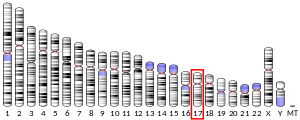CCL23
Le CCL23 (pour « Chemokine (C-C motif) ligand 23 »), appelé aussi β8‐1 (Ckβ8‐1), MPIF‐1 pour « myeloid progenitor inhibitory factor 1 » ou MIP‐3 pour « macrophage inflammatory protein 3 », est une chimiokine. Son gène est CCL23 situé sur le chromosome 17 humain.
Rôles
modifierIl se lie au CCR1[5] et permet l'attraction des polynucléaires neutrophiles, des monocytes et des lymphocytes[6]. Il inhibe la prolifération de certaines cellules souches hématopoïétique[7].
Il jouerait un rôle dans la genèse de l'athérome[8] et dans l'angiogenèse par l'intermédiaire d'une augmentation de l'expression de la métalloprotéinase matricielle 2[9] et de la voie du KDR/Flk-1[10].
En médecine
modifierSon taux sanguin est augmenté dans la polyarthrite rhumatoïde[11], dans la sclérodermie[12] ainsi que lors d'un accident vasculaire cérébral[13].
Notes et références
modifier- ENSG00000274736 GRCh38: Ensembl release 89: ENSG00000276114, ENSG00000274736 - Ensembl, May 2017
- GRCm38: Ensembl release 89: ENSMUSG00000018927 - Ensembl, May 2017
- « Publications PubMed pour l'Homme », sur National Center for Biotechnology Information, U.S. National Library of Medicine
- « Publications PubMed pour la Souris », sur National Center for Biotechnology Information, U.S. National Library of Medicine
- Youn BS, Zhang SM, Broxmeyer HE et al. Characterization of CKbeta8 and CKbeta8‐1: two alternatively spliced forms of human beta‐chemokine, chemoattractants for neutrophils, monocytes, and lymphocytes, and potent agonists at CC chemokine receptor 1, Blood, 1998;91;3118–26
- Kim J, Kim YS, Ko J, CK beta 8/CCL23 induces cell migration via the Gi/Go protein/PLC/PKC delta/NF‐kappa B and is involved in inflammatory responses, Life Sci, 2010;86:300–8
- Patel VP, Kreider BL, Li Y et al. Molecular and functional characterization of two novel human C‐C chemokines as inhibitors of two distinct classes of myeloid progenitors, J Exp Med, 1997;185:1163–72
- Kim CS, Kang JH, Cho HR et al. Potential involvement of CCL23 in atherosclerotic lesion formation/progression by the enhancement of chemotaxis, adhesion molecule expression, and MMP‐2 release from monocytes, Inflamm Res, 2011;60:889–95
- Son K‐N, Hwang J, Kwon BS, Kim J, Human CC chemokine CCL23 enhances expression of matrix metalloproteinase‐2 and invasion of vascular endothelial cells, Biochem Biophys Res Commun, 2006;340:498–504
- Han KY, Kim CW, Lee TH, Son Y, Kim J, CCL23 up‐regulates expression of KDR/Flk‐1 and potentiates VEGF‐induced proliferation and migration of human endothelial cells, Biochem Biophys Res Commun, 2009;382:124–8
- Rioja I, Hughes FJ, Sharp CH et al. Potential novel biomarkers of disease activity in rheumatoid arthritis patients: CXCL13, CCL23, transforming growth factor alpha, tumor necrosis factor receptor superfamily member 9, and macrophage colony‐stimulating factor, Arthritis Rheum, 2008;58:2257–67
- Yanaba K, Yoshizaki A, Muroi E et al. Serum CCL23 levels are increased in patients with systemic sclerosis, Arch Dermatol Res, 2011;303:29–34
- Simats A, García‐Berrocoso T, Penalba A et al. CCL23: a new CC chemokine involved in human brain damage, J Int Med, 2018;283: 461-475




